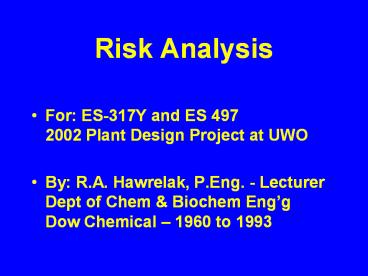Risk Analysis - PowerPoint PPT Presentation
Title:
Risk Analysis
Description:
A risk analysis is any study that identifies hazardous concerns. ... Individual Risk negligible at 1E-08 chance of fatality per year. ... Facility data. ... – PowerPoint PPT presentation
Number of Views:273
Avg rating:3.0/5.0
Title: Risk Analysis
1
Risk Analysis
- For ES-317Y and ES 497 2002 Plant
Design Project at UWO - By R.A. Hawrelak, P.Eng. - Lecturer
Dept of Chem Biochem Engg
Dow Chemical 1960 to 1993
2
What is Risk Analysis?
- A risk analysis is any study that identifies
hazardous concerns. - There are many types of risk analyses (PHA,
HAZOP, Dow Fire and Explosion Index, QRA). - Two basic methodologies. One is
a Deterministic Method and the other is a
Probabilistic Method.
3
Deterministic Methods
- How far to LEL?
- How far to second degree burns?
- How far to 1 psig Overpressure in a VCE (building
damage)? - How far to ERPG2 - a toxic concentration endpoint
for a dispersion.
4
Probabilistic Method
- Quantitative Risk Analysis (QRA)
- What is probability of reaching the LEL at a
certain distance? - What is probability of receiving second degree
burns? - What is probability of receiving 1 psig
Overpressure from a VCE?
5
Netherlands Opts For QRA
- Detailed QRA legislated by law. Permits reqd for
all plants. - Individual Risk negligible at 1E-08 chance of
fatality per year. - Societal Risk required to meet specified
Guidelines. - All companies use SAFETI, a huge, complex
computer model.
6
Dutch Individual Risk
7
Dutch Societal Risk
8
Great Britain Opts For QRA
- Detailed QRA required if HSE deems the plant
exceeds certain planning criteria. - QRA can be performed by HSE or any recognized
risk company. - HSE has proposed 1E-06 chance of fatality as a
level of risk that would be broadly acceptable to
members of the public.
9
US EPA Opts For A Deterministic Risk Method
- Risk Management Plan (RMP) became law on 20 June,
1996. - Worst Case Scenario and Alternative Scenario for
each toxic chemical. - Only one flammable scenario - Worst Case and
Alternative, the one that impacts on the public
to the greatest extent.
10
U.S. RMP Computer Program
- RMP Manual available with 27 examples or .
- Free download of RMP computer program at
http//www.epa.gov/ceppo/tools/rmp-comp/rmp-comp.h
tml - Download it on to your hard disc.
- Its very simple to use.
- If you dont know your storage quantity yet, run
the threshold quantity to see how big a problem
you may have. You may decide to store less.
11
1994 - Canada Opts For Guidelines
- Major Industrial Accidents Council of Canada
(MIACC). - MIACC modifies Dutch Guide To Hazardous
Industrial Activities. - A two point probabilistic method using Individual
Risk as negligible at 1E-06. - Dow Chemical does not accept the two point
concept because it is fundamentally flawed (RAH
MIACC rep for Dow).
12
MIACC Publications
- Lists of Hazardous Substances - 1994
- Hazardous Substances Risk Assessment a
Mini-Guide for Municipalities and Industry. - Risk Assessment Guidelines for Municipalities and
Industries - An Initial Screening Tool.
13
New Canadian Draft Regulation
- Ottawa, August 20, 2002.
- Industrial Facilities that handle dangerous
substances will be required to develop accident
prevention plans. - http//www.ec.gc.ca/press/2002/020820_n_e.htm
- Environmental Emergency (E2) Regulations under
Canadian Environmental Protection Act, 1999 (CEPA
1999) - Targets an initial list of 174 substances.
14
What Info Included in E2 Plan?
- Senior management commitment.
- Types of on-site and off-site emergencies.
- A description of individual roles
responsibilities. - Contact lists.
- Training logs.
- A means for ensuring the plan is current,
comprehensive and effective.
15
E2 Implementation
- 1500 facilities expected to comply with the
proposed regulation. - Must develop, implement and test an emergency
plan within 1 year of the regulation coming into
effect. - Regulation is expected to be in place early in
2003.
16
E2 Submissions
- E2 plans will not be submitted.
- Two declarations must be submitted.
- (1) A declaration that a E2 plan has been
prepared and is being implemented. - (2) A declaration of implementation indicating
that implementation of the E2 plan has been
completed.
17
Info in Declarations
- Facility data.
- An indication of whether or not environmental
emergency prevention, preparedness, response and
recovery measures are identified in the plan. - An indication that information from previous
environmental emergencies has been incorporated
into the plan.
18
Key References Used in E2
- See Appendix 3 in Draft Regulation.
- Quebec Guide CRAIM, Risk management for Major
Industrial Accidents intended for municipalities
and Industry (Based on U.S. RMP). - Hazardous Substances Risk Assessment a
Mini-Guide for Municipalities and Industry.
(Flawed methodology RAH).
19
E-2 Concerns
- Need to Question the threshold quantity in List
of Substances. - Concern that smaller quantities may impact on the
public in areas where the public is too close to
the chemical facility. - Concern regarding lack of a permit to operate.
The EPA gives a permit to operate based on the
RMP program.
20
RMP Concerns
- RMP stresses ERPG2 end points for toxic
chemicals. This low concentration results in long
impact distance for any given dispersion. - RMP requires ER planning over a large area which
is difficult to plan and manage. - RMP does not identify acute hazardous areas
closer to the source. These area are extremely
vulnerable in short time frames. - Use of alternate dispersion models must be
qualified against known data points. - RMP focus is on storage. More hazardous areas
such as reactors are not included (Flixborough).
21
End of Presentation
- Good luck on your project.
- Questions can be asked via e-mail at
richardhaw_at_sympatico.ca































